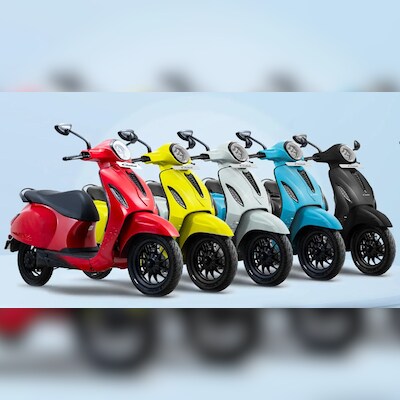Bajaj Auto’s affordable Chetak 2901 charges up electric scooter market
Two-wheeler maker Bajaj Auto on Friday unveiled its latest offering — the Chetak 2901, a competitively priced e-scooter that is likely to heat the market further, challenging its peers which have also been introducing relatively affordable models in recent months.
Industry experts believe that major two-wheeler manufacturers are now shifting their focus to the sub-Rs 1 lakh segment in e-scooters. They have already captured an 80 per cent share of this segment, a significant increase from the 50-60 per cent share they held about a year ago.
The Chetak 2901, priced from Rs 95,998, is equipped with a 2.8 kWh battery pack, and claims to offer a range of 123 km and a top speed of 63 km per hour. In contrast, the Chetak Urbane (2.9 kWh) starts at Rs 1.23 lakh, while the Chetak Premium (3.2 kWh) begins at Rs 1.47 lakh.
Other two-wheeler makers, too, have competitive offerings. Ola recently reduced the starting price of its S1X model (4 kWh) to Rs 70,000, while Ather introduced its family scooter Rizta at a starting price of Rs 1.1 lakh. Also, TVS’ iQube starts at Rs 1.1 lakh.
ALSO READ: Bajaj Auto appoints Abraham Joseph as MD of its EV arm Chetak Technology
Eric Vas, president of Urbanite at Bajaj Auto, stated that the company has already begun shipping the Chetak 2901 to dealerships. He elaborated on the strategy to price it affordably, stating that the Chetak 2901 is “designed, specced, and priced to attract customers who are currently purchasing a petrol scooter to a full-size metal body electric scooter that can match and exceed a petrol scooter, without denting their wallet”.
Retail sales will commence from 15 June onwards. Vas expressed his belief that the Chetak 2901 will “dramatically expand the electric scooter market”.
So, is the market witnessing a shift towards affordable e-scooters? Rakesh Sharma, executive director of Bajaj Auto, told Business Standard that the top five players have indeed started to “attack” the sub-Rs 1 lakh price point. He noted that the market shares of smaller players operating at this price point have shrunk with the entry of the big players. “The split earlier was 50:50 (between sub-Rs 1 lakh and the more expensive scooters). It remains the same now, too — just that the top five players now have 80 per cent of the market,” he explained.
Electric two-wheeler sales shot up by more than 65 per cent in March compared to February as the FAME II subsidy was about to expire. At the end of March, the Centre launched the Electric Mobility Promotion Scheme (EMPS) for four months and it replaced the FAME II subsidy scheme. The subsidy, however, was capped at only Rs 10,000 per vehicle, half of what was offered under the previous scheme. Several companies had to pass on the impact of the less subsidy to consumers, which affected overall e-two-wheeler sales in April and May.
According to SMEV (Society of Manufacturers of Electric Vehicles) data, electric two-wheeler sales nearly halved in April (compared to March) to 64,511 units and continued to slide further in May (63,841 units).
Despite these challenges, Bajaj Auto has been aggressively expanding the Chetak dealership network, with the scooter now available across more than 500 showrooms in the country. The Chetak range of scooters has received approval for the EMPS subsidy from the Ministry of Heavy Industries (MHI), and Bajaj Auto is part of the Government of India’s Production-Linked Incentive (PLI) Scheme for electric vehicles.
Sharma noted that the Chetak did well to close 2023-24 at the Number 3 position, at least three notches up from the beginning of FY24, in a “fiercely competitive environment”. He expects electric two-wheelers to continue to grow by cornering the ICE scooter market.
In the fourth quarter of 2023-24, Chetak delivered its highest quarterly volume of around 40,000 units, more than the total sales during the entire FY23.
Sharma felt that electric two-wheelers performed well in FY24, with high-speed models growing by almost 28 per cent. In FY25, following the withdrawal of the subsidy, growth is expected to be in the high teens.
With plans to export the Chetak to Europe this calendar year, Bajaj Auto is also looking to make an impact on the global electric scooter market.
· At its peak it had waiting period of upto 10 years in 1980
· Bajaj had sold 500,000 units of the Chetak by 1983; 100 mn units by 1995
· As competition grew Bajaj discontinued the Chetak in 2004
· In October 2019 the co re-introduced the iconic scooter brand in an electric avatar
First Published: Jun 07 2024 | 6:42 PM IST
